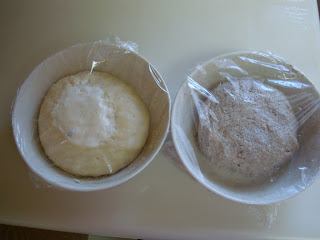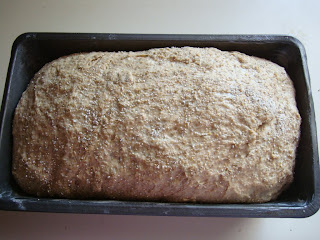I am decisively moving from whole wheat to a broader spectrum of grains. Here is my first rye loaf, following Peter Reinhart's recipe from his whole grain baking book.
Recipe: Half-rye sandwich loaf (1 large loaf)
Ingredients:
soaker
- 1+1/3 cup Hodgson Mill stone ground whole rye flour
- 7 TB King Arthur whole wheat flour
- 1/2 tp salt
- 3/4 cup homemade plain yogurt
- 1/4 cup water
biga
- 1+3/4 cup King Arthur bread flour
- 1/4+1/8 tp active dry yeast
- 2-3 TB warm water for proofing yeast
- 1/2 cup water
final dough
- 2+1/2 tp active dry yeast, proofed in 1 TB water
- 1/2 tp salt
- 1+1/2 TB molasses
- 1 TB vegetable oil
- extra 1/4 cup plain yogurt to further soften the soaker before mixing
- 8 TB whole rye flour
others
- 1/2 TB butter and 1 tp white flour to grease a large 5"x9" loaf pan
Procedure:
Day 1
Mix the soaker and the biga separately, and let each go through autolyse. Allow both to chill.
Day 2
1. If soaker seems too dry, add in 1/4 cup of plain yogurt and work it into the soaker.
2. Take both biga and soaker out to warm to room temperature.
3. Chop biga and soaker into small pieces. Mix and add salt, proofed yeast, molasses and vegetable oil.
4. After the initial mixing of the final dough, add rye flour to adjust the hydration level of the final dough until it's rather strong.
5. Grease a large loaf pan generously with butter. Dust with flour.
6. Allow the dough to rest in the pan until volume increases by 1.5 times.
Results:
Day 1, 2:30pm, soaker ingredients:
Day 1, 2:35pm, soaker initially mixed with only yogurt:
Day 1, 2:38pm, soaker after 3 minutes of mixing with 1/4 cup of water:
Day 1, 2:50pm, soaker forming a dry dough with cracks:
Day 1, 2:58pm, soaker allowed to rest 8 minutes, softened and moistened:
Day 1, 2:59pm, biga initially mixed:
Day 1, 3:06pm, biga mixed 6 minutes:
Day 1, 3:12pm, biga done:
Day 1, 3:15pm, both soaker and biga ready to chill:
Day 2, 7:54am, additional 1/4 cup of yogurt added to soaker to soften it further:
Day 2, 7:57am, biga and soaker to warm up:
Day 2, 9:57am, biga and soaker warmed for 2 hours:
Day 2, 9:58am, biga's texture:
Day 2, 10:00am, soaker's texture:
Day 2, 10:26am, final dough mixed and molasses just added:
Day 2, 10:46am, final dough done, extra rye flour added to absorb its moisture:
Day 2, 10:59m, final dough allowed to rise:
Day 2, 11:53am, final dough rested for 1 hour:
Day 2, 11:56am, final dough scored:
Day 2, 12:01pm, final dough's height before baking:
Day 2, 12:14pm, loaf after the first 10 minutes of baking; top has browned, and needs to be covered for the rest of the baking:
Day 2, 12:57pm, loaf baked 55 minutes:
Day 2, 12:57pm, loaf's height:
Day 2, 12:58pm, loaf's bottom and side:
Day 2, 12:59pm, loaf's corner:
Day 2, 12:59pm, loaf's top:
Day 2, 2:16pm, loaf very slightly collapsed after cooling:
Day 2, 2:24pm, loaf yielding 18 slices:
Day 2, 2:24pm, a center-of-loaf slice:
Day 2, 2:24pm, an end-of-loaf slice:
Day 2, 2:25pm, a cracked slice:
Day 2, 2:27pm, an unevenly mixed slice:
Observation:
1. In this experiment, I study not only how to handle rye, but also how the King Arthur bread flour behave.
2. Observation, this time I am using the King Arthur bread flour. I can see a distinctive character in my biga. It's so much stronger!
3. The half-rye bread is much softer than whole wheat bread.
4. Taste-wise, I really can't tell a huge difference. There may be some subtle difference between rye and wheat.
5. In this first experiment, it's pretty obvious that I have not developed good control over the hydration level of this bread. Both the bread flour and the rye flour are new to me. I must have added too much water (and yogurt) to the pre-ferments.
6. Rye does not rise much. So it may actually make more sense to make hearth bread out of it instead of sandwich loaves which are expected to have a certain size and volume.
In the future, I may try baking rye bread as a much denser round loaf than a sandwich loaf for daily lunch.
Subscribe to:
Post Comments (Atom)



































No comments:
Post a Comment